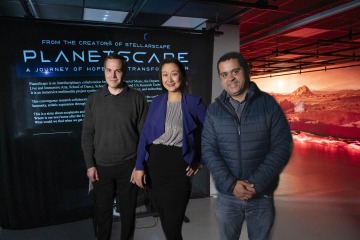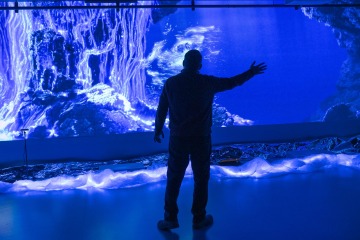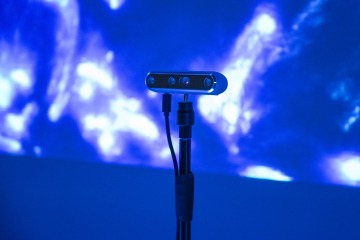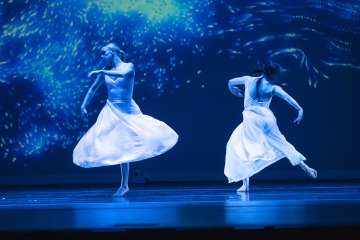PlanetScape: Fusing art, science and technology
A University of Arizona Health Sciences SensorLab collaboration cultivates creativity with a unique multimedia performance and interactive exhibit.
Earth. It is the only home we have ever known.

From left: Peter Torpey, PhD, Yuanyuan Kay He, DMA, and Gustavo de Oliveira Almeida, PhD, used SensorLab equipment to create the interactive component of PlanetScape.
What happens if one day we are forced to leave or decide to go on a journey of exploration? Where do we go? If we need to leave our solar system, how long would it take to find a place where we could survive? Could we adapt to an alien world?
These ideas are the foundation of PlanetScape, a multimedia collaboration between the University of Arizona Health Sciences SensorLab, the UArizona College of Fine Arts, the UArizona College of Science’s Department of Astronomy and the UArizona School of Information. The project blended art, science and interactive technology in a way that enlivened the senses and acted as a catalyst for creativity for artists and scientists.
“We are all focused on and passionate about our individual fields of study, but I believe science, technology and art can all be thought of as different components of humanity,” said Yuanyuan Kay He, DMA, co-director of PlanetScape and assistant professor in the College of Fine Arts. “After all, scientists do say we are all made up of the same stardust brought to life.”
PlanetScape was made possible by the team’s previous collaboration on StellarScape, a multimedia performance about the life of a star. StellerScape was one of eight projects that received seed-grant funding from the SensorLab.
Interacting with science through art
PlanetScape’s first public appearance was as an immersive experience in the SensorLab, a UArizona Health Sciences initiative to advance novel human-centered hardware and software sensor systems that detect, monitor, analyze and provide real-time feedback relating to human physiology and behavior. The space, co-located with the Holodeck – normally a blank slate configurable for studies, testing and validation – was transformed into a brilliant canvas of light as it portrayed distant worlds.

The UArizona Health Sciences SensorLab was transformed into an immersive art exhibit, where visitors “flew” to three different exoplanets and interacted with extreme environments including a water world.
Three exoplanets, or planets outside of the solar system, were modelled after types of worlds already known to exist – a lava world, an ice world and a water world. The exhibit allowed visitors to fly to these planets and engage with the different environments through sensors that were located strategically around the room.
“For the exhibit, we used depth-sensing cameras,” said Gustavo de Oliveira Almeida, PhD, SensorLab coordinator and a member of the BIO5 Institute. “This kind of camera is used to help robots navigate. It understands the environment, objects and movement. It feeds this information into special software to create the visual interaction between people and the landscape.”
Then, on Jan. 26, PlanetScape was presented at Crowder Hall as a live performance that synthesized music, science, visual art and technology. The SensorLab provided equipment so that the dancers could interact with the celestial bodies during the live performance.
“There is a term that cosmologists often use when it comes to habitable planets called the ‘Goldilocks zone.’ Depending on the proximity of its sun, it might be too hot, too cold or just right,” said Peter Torpey, PhD, co-director of PlanetScape and director of the Live and Immersive Arts Program in the College of Fine Arts. “The music, the dance, the lighting and all the visuals come together to represent our hero’s journey as she visits worlds in each of these zones. In some cases, the other dancers might represent creatures on these planets or part of the landscape itself. The music underscores her feelings at each stage of the voyage.”
The science behind the art
It may come as a surprise that researchers have identified many planets with the potential to support life.

Depth-sensing cameras allowed visitors at the immersive exhibit and dancers on stage to interact with their environment.
“In round numbers, there is at least one planet for every star in our Milky Way galaxy. That equates to about 200 billion and of those about 10% are in the habitable zone,” said UArizona Distinguished Professor of astronomy Chris Impey, PhD. “So, that could be 10 to 20 billion habitable worlds just in our galaxy.”
Impey, an astronomer at Steward Observatory, collaborated on PlanetScape and provided the background science for the story. Impey said the biggest problem with finding a new home planet is the vast distance one would have to travel.
“We did have to take some artistic license and put our hero in a state of suspended animation similar to what you might see in a Hollywood movie,” he said. “Our hero travels to three different planets, and at 5% of lightspeed, her shortest trip takes a century and her longest takes a thousand years.”
Art and science complement to each other, and there is scientific evidence that art can have powerful effects on human health.
“I think art and health, especially mental health, are closely related. I've been involved in some work with music that goes a bit beyond art therapy, and it has an amazing effect on people,” Torpey said. “Music has been shown to be wonderfully calming for people with Alzheimer's disease and dementia, and in some cases, a song can be one of the last things a patient remembers.”
Torpey’s colleague He agreed, and said, “Research shows certain types of music can trigger different emotions. I watched students enter the SensorLab and enjoy the experience. If someone was in a bad mood, immersive art could lift them up and ignite their imagination.”

Dancers tested the interactive sensors during a dress rehearsal the day before performing PlanetScape live at Crowder Hall.
As for PlanetScape, the hero does find a new home. Liquid water is essential to life as we know it, so she ends up settling on the water world.
“It is kind of ambiguous whether our hero leaves Earth because it was destroyed or if she was propelled by human curiosity like so many explorers throughout history,” Torpey said. “But it is daunting to think about what would happen if we don’t take care of our planet and humanity needs to find a new home.”
As for Almeida and the SensorLab, the collaboration sparked the kind of creativity needed to pursue new scientific endeavors.
“These projects stretched our boundaries and the way we normally think,” Almeida said. “We are used to picturing our equipment in a well-lit, clinical setting. We had to change that for the performances and the exhibit to make things work in darkness. That new application could possibly be applied to a home-care setting or in some way we haven’t even thought of yet.”
Our Experts
Gustavo de Oliveira Almeida, PhD
Coordinator, SensorLab
Member, BIO5 Institute
Yuanyuan Kay He, DMA
Assistant professor, UArizona College of Fine Arts
Peter Torpey, PhD
Director, Live and Immersive Arts Program, College of Fine Arts
Chris Impey, PhD
Distinguished Professor, Department of Astronomy, College of Science
Astronomer, Steward Observatory
Winslow Burleson, PhD
Professor, UArizona School of Information
Professor, BIO5 Institute
Contact
Brian Brennan
University of Arizona Health Sciences Office of Communications
520-621-3510, brianbrennan@arizona.edu

